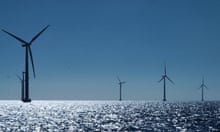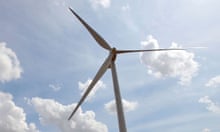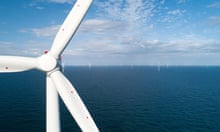One of the world’s biggest wind turbine makers has reignited concerns over the headwinds facing the industry after losing billions in market value this week.
Shares in Siemens Energy, the owner of the turbine manufacturer Siemens Gamesa, plummeted after it emerged that the company was in rescue talks with the German government to secure €15bn of guarantees to shore up its balance sheet. The company expects heavy losses this year after faults were discovered in its newest turbine models.
Claudia Kemfert, an energy expert at the German Institute of Economic Research in Berlin, said that while Siemens’ wind power woes were “tragic” they were not emblematic of the wind industry, which was in good shape overall.
“Wind power is literally on the rise globally,” Kemfert said. “The problems at Siemens Gamesa are homemade. The group must get a grip on quality problems. The fact that this has not been done to a sufficient degree to date is astonishing and must be changed.”
Still, some fear that a troubling trend has emerged: the climbing costs of financing and building windfarms have created headwinds for those constructing offshore windfarms around the world. Inflation is casting doubt on the future of multibillion-pound wind projects. In time, the sector-wide cost pressures could threaten government renewable energy targets too.
Which wind power companies have been affected by climbing costs?
Sweden’s Vattenfall raised a red flag over rising costs this summer, halting work on its giant offshore windfarm off the Norfolk coast.
Vattenfall said it would stop work on Norfolk Boreas, designed to power the equivalent of 1.5m British homes, because a 40% increase in its costs, in large part due to higher prices for energy and materials, meant it was no longer profitable.
Vattenfall bid a record low price of £37.35 per megawatt hour (MWh) to win a government support contract for the project but, following a surge in global energy prices, said it would now need a “significantly higher” subsidy for its project to make financial sense.
Along with SSE and ScottishPower, it warned the UK government that its late summer auction for new subsidy contracts was set too low to cover costs. The government ignored calls for the auction to start at a higher price and no new offshore windfarms bid for contracts.
The Danish windfarm giant Ørsted, meanwhile, has raised concerns about supply chain glitches and soaring interest rates, and told investors of a near £2bn writedown due to delays to a string of windfarm projects in the US.
Which windfarms risk being derailed?
Ørsted has said there is a very real chance that it will drop plans to build its US windfarms entirely if the US government does not take steps to help.
The company is spearheading seven projects in the north-east of the US, enough to supply the equivalent of 2m homes with clean electricity. Its three largest projects due for completion in the next few years lie off the coasts of New Jersey, Rhode Island and New York’s Long Island.
In the UK, Ørsted had planned to develop the Hornsea 3 windfarm after winning a contract on the same terms as Vattenfall’s Norfolk Boreas – it is yet to commit to a final investment decision on the project.
after newsletter promotion
The UK government’s failure to secure any new offshore windfarms in its latest subsidy auction meant the industry missed out on a potential of 5GW worth of new offshore wind capacity, or enough to power nearly 8m homes a year.
What does this mean for climate action?
Energy economists have warned that the slowdown in the offshore wind industry spells trouble for governments with renewable energy targets. The UK set out an aim to increase its offshore wind capacity fivefold to reach 50GW by the end of the decade. This week, analysts at Cornwall Insight said the UK was likely to miss this target, jeopardising the government’s legally binding commitment to reduce emissions to net zero by 2050. It expects UK offshore wind to reach 47GW by 2030.
In the US, Joe Biden set an offshore wind target of 30GW by 2030. But analysts at BloombergNEF cut their forecasts to just 16.4GW by the end of the decade after policymakers in New York forcefully rejected developers’ pleas for higher rates earlier this month. The slowdown casts doubt on the US ability to meet its climate commitments, including the country’s Paris agreement pledge to at least halve greenhouse gas emissions from 2005 levels by the end of the decade.
What can governments do to help?
The UK government has promised to review its auction process for offshore wind. Europe has taken a more proactive approach. The European Commission president, Ursula von der Leyen, identified access to adequate financial guarantees as a major problem for the entire wind energy sector in her annual “state of the union” speech.
Earlier this week, the commission unveiled its new “wind power package” of measures including plans to help windfarm developers access finance. Von der Leyen said: “We will fast-track permitting even more. We will improve the auction systems across the EU. We will focus on skills, access to finance and stable supply chains.”
She concluded that “the future of our clean tech industry has to be made in Europe”. Her words are sobering reading for policymakers in the UK and the US.










